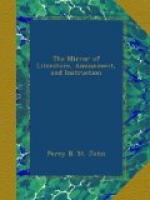as common plates and dishes, to the compact ware not
requiring glazing, of which he made mortars and other
similar articles. The almost infusible nature
of the body allowed him also to employ a thinner and
less fusible glaze, that is, one in which no more
lead entered than in common flint glass, and therefore
incapable of being affected by any articles of food
contained or prepared in such vessels. With these
materials, either in their natural white or variously
coloured—black by manganese, blue by cobalt,
brown and buff by iron—he produced imitations
of the Etruscan vases, and of various other works
of ancient art, such as the world had never before
seen—such as no subsequent artist has ever
attempted to rival. His copies of the Portland
vase are miracles of skill; and the other specimens
of similar works may give some idea of the many beautiful
works that were produced in his manufactory. In
table ware, for many years he led the way almost without
a rival; but the immense demand occasioned by the
successive improvements of this article, which first
put down the use of delft, and then of pewter, gave
ample room and encouragement to men of capital and
skill to enter the field of profit and competition.
Much good has hence resulted; many subordinate improvements
have been effected and are almost daily making; and
a new variety of ware, called ironstone, has been
invented, and so rapidly and judiciously improved,
that, in appearance and in many of its intrinsic properties,
it bears a close resemblance to the older and coarser
porcelains of China itself.
I shall conclude by a summary account of the manufacture
of the best table ware; for a considerable part of
which I am indebted to notes taken by Captain Bagnold,
when visiting a pottery, inferior, perhaps, to none
in the country.
The materials of the Staffordshire ware are calcined
flints and clay. The flints are burnt in kilns,
and then, while hot, quenched in water, by which they
are cracked through their whole substance. After
being quenched they are ground in mills with water.
The mill is a hollow cylinder of wood bound with hoops,
and having a bottom of blocks of chert, a hard, tough,
siliceous stone: the mill-shaft is perpendicular,
and has two horizontal arms passing through it cross-wise.
Between these arms are laid loose blocks of chert,
which are moved round on the bed-stone as the arms
revolve, and thus grind the flint with water to the
consistence of cream.
The clay, from Dorsetshire and Devonshire, is mixed
with water, and in this state is passed through fine
sieves to separate the grosser particles. The
flint and clay are now mixed by measure, and the mud
or cream is passed through a sieve in order to render
the mixture more complete.




